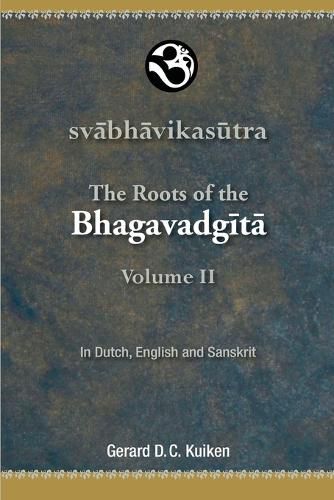Readings Newsletter
Become a Readings Member to make your shopping experience even easier.
Sign in or sign up for free!
You’re not far away from qualifying for FREE standard shipping within Australia
You’ve qualified for FREE standard shipping within Australia
The cart is loading…






This title is printed to order. This book may have been self-published. If so, we cannot guarantee the quality of the content. In the main most books will have gone through the editing process however some may not. We therefore suggest that you be aware of this before ordering this book. If in doubt check either the author or publisher’s details as we are unable to accept any returns unless they are faulty. Please contact us if you have any questions.
The first 51 pages of this Volume II of the "Svabhavikasutra: The Roots of the Bhagavadgita extends and substantiates the introduction given in Part Two of Volume I: "Comments on the Svabhavikasutra." "Dating the Bhagavadgita" reviews the date of Buddha's death, the chronology of the Upanisads, layered structures in the Bhagavadgita, and the dating of the Mahabharata. "A Review of the Search for Its Original" examines the critical editions of the Mahabharata and the Bhagavadgita, the Ur-Bhagavadgitas by von Humboldt, Garbe and Otto, Jacobi and Oldenberg, Sinha, and Jezic; the three authors and layers defined by Khair and Malinar; the extended Bhagavadgita by Bhattacharjya; and the source text of the Bhagavadgita, the Svabhavikasutra, found by Saswitha. "The Class-Caste System with Its Genetic Evidence" discusses and shows that the caste system in India was introduced in the last centuries BCE. It is suggested that it was promoted by the brahmins for political rather than spiritual reasons. In Vedic times admixture was the norm, where one chose one's own partner, as is confirmed by recently found genomic data. An overall generation length for the Indian people has been derived from long-term population growth, historic data, and data from genomic studies. Applying this length also confirms the brahmanization of northern India 70 generations ago, and the late first occurrence of a large, four-armed sculpture of Krishna among the bas-reliefs of Badami (c. 500-800 CE). There is no reference either to a class-caste system or to a theistic devotion to Krishna in the Svabhavikasutra. Pages 52-175 give a detailed grammatical commentary with a vocabulary to explain the choices made for the translation into Sanskrit of the Svabhavikasutra, together with the Dutch and English versions.
$9.00 standard shipping within Australia
FREE standard shipping within Australia for orders over $100.00
Express & International shipping calculated at checkout
This title is printed to order. This book may have been self-published. If so, we cannot guarantee the quality of the content. In the main most books will have gone through the editing process however some may not. We therefore suggest that you be aware of this before ordering this book. If in doubt check either the author or publisher’s details as we are unable to accept any returns unless they are faulty. Please contact us if you have any questions.
The first 51 pages of this Volume II of the "Svabhavikasutra: The Roots of the Bhagavadgita extends and substantiates the introduction given in Part Two of Volume I: "Comments on the Svabhavikasutra." "Dating the Bhagavadgita" reviews the date of Buddha's death, the chronology of the Upanisads, layered structures in the Bhagavadgita, and the dating of the Mahabharata. "A Review of the Search for Its Original" examines the critical editions of the Mahabharata and the Bhagavadgita, the Ur-Bhagavadgitas by von Humboldt, Garbe and Otto, Jacobi and Oldenberg, Sinha, and Jezic; the three authors and layers defined by Khair and Malinar; the extended Bhagavadgita by Bhattacharjya; and the source text of the Bhagavadgita, the Svabhavikasutra, found by Saswitha. "The Class-Caste System with Its Genetic Evidence" discusses and shows that the caste system in India was introduced in the last centuries BCE. It is suggested that it was promoted by the brahmins for political rather than spiritual reasons. In Vedic times admixture was the norm, where one chose one's own partner, as is confirmed by recently found genomic data. An overall generation length for the Indian people has been derived from long-term population growth, historic data, and data from genomic studies. Applying this length also confirms the brahmanization of northern India 70 generations ago, and the late first occurrence of a large, four-armed sculpture of Krishna among the bas-reliefs of Badami (c. 500-800 CE). There is no reference either to a class-caste system or to a theistic devotion to Krishna in the Svabhavikasutra. Pages 52-175 give a detailed grammatical commentary with a vocabulary to explain the choices made for the translation into Sanskrit of the Svabhavikasutra, together with the Dutch and English versions.